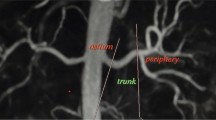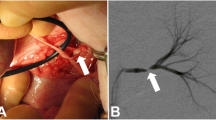Abstract
Objectives
To compare non-enhanced magnetic resonance angiography (NE-MRA) between 1.5 and 3.0-T using a balanced steady-state free precession (bSSFP) sequence in the assessment of renal artery stenosis (RAS) with digital subtraction angiography (DSA) as a reference standard.
Methods
From March 2016 to May 2018, 81 patients suspected to have significant RAS were scheduled for DSA. All patients underwent NE-MRA at either 1.5 T or 3.0 T randomly before DSA. In total, 49 patients underwent 1.5-T NE-MRA, and 32 patients underwent 3.0-T NE-MRA. Image quality was assessed. Degree of stenosis evaluated with NE-MRA was compared with that with DSA.
Results
NE-MRA provided excellent image qualities for segment 1 and segment 2 at 1.5 T and 3.0 T. Image qualities for segment 3 and segment 4 and the degree of renal artery branches were significantly higher at 3.0 T than at 1.5 T (p < 0.01). Stenoses evaluated with NE-MRA at 1.5 T (r = 0.853, p < 0.01) and 3.0 T (r = 0.811, p < 0.01) were highly correlated with those of DSA. The Bland-Altman plots showed overestimated degrees of stenosis at 1.5 T (mean bias, 3.5% ± 20.4) and 3.0 T (mean bias, 8.4% ± 21.7). The sensitivity and specificity for significant stenosis were 97.4% and 89.8% for 1.5 T and 95.7% and 91.1% for 3.0 T.
Conclusions
Both 1.5-T and 3.0-T bSSFP NE-MRA can reliably assess RAS, with high image quality and good diagnostic accuracy. Performing NE-MRA at 3.0 T significantly improved visualization of renal artery branches but showed greater tendency to overestimate stenosis compared with that at 1.5 T.
Key Points
• Both 1.5-T and 3.0-T NE-MRA provide excellent image quality and good diagnostic accuracy for RAS.
• NE-MRA at 3.0 T improved visualization of renal artery branches compared with that at 1.5 T.






Similar content being viewed by others
Abbreviations
- bSSFP:
-
Balanced steady-state free precession
- CE-MRA:
-
Contrast-enhanced magnetic resonance angiography
- CIN:
-
Contrast-induced nephropathy
- DSA:
-
Digital subtraction angiography
- FMD:
-
Fibromuscular dysplasia
- MIP:
-
Maximum intensity projection
- NE-MRA:
-
Non-enhanced magnetic resonance angiography
- NSF:
-
Nephrogenic systemic fibrosis
- PSV:
-
Peak systolic velocity
- RAS:
-
Renal artery stenosis
References
Safian RD, Textor SC (2001) Renal-artery stenosis. N Engl J Med 344:431–442
Garovic VD, Textor SC (2005) Renovascular hypertension and ischemic nephropathy. Circulation 112:1362–1374
Gray BH, Olin JW, Childs MB, Sullivan TM, Bacharach JM (2002) Clinical benefit of renal artery angioplasty with stenting for the control of recurrent and refractory congestive heart failure. Vasc Med 7:275–279
Cooper CJ, Murphy TP, Cutlip DE et al (2014) Stenting and medical therapy for atherosclerotic renal-artery stenosis. N Engl J Med 370:13–22
Colyer WR, Eltahawy E, Cooper CJ (2011) Renal artery stenosis: optimizing diagnosis and treatment. Prog Cardiovasc Dis 54:29–35
Hirsch AT, Haskal ZJ, Hertzer NR et al (2006) ACC/AHA 2005 practice guidelines for the management of patients with peripheral arterial disease (lower extremity, renal, mesenteric, and abdominal aortic): a collaborative report from the American Association for Vascular Surgery/Society for Vascular Surgery, Society for Cardiovascular Angiography and Interventions, Society for Vascular Medicine and Biology, Society of Interventional Radiology, and the ACC/AHA Task Force on Practice Guidelines (Writing Committee to Develop Guidelines for the Management of Patients With Peripheral Arterial Disease): endorsed by the American Association of Cardiovascular and Pulmonary Rehabilitation; National Heart, Lung, and Blood Institute; Society for Vascular Nursing; TransAtlantic Inter-Society Consensus; and Vascular Disease Foundation. Circulation 113:e463–e654
White CJ (2009) Management of renal artery stenosis: the case for intervention, defending current guidelines, and screening (drive-by) renal angiography at the time of catheterization. Prog Cardiovasc Dis 52:229–237
Tafur JD, White CJ (2017) Renal artery stenosis: when to revascularize in 2017. Curr Probl Cardiol 42:110–135
Textor SC, McKusick MM (2016) Renal artery stenosis: if and when to intervene. Curr Opin Nephrol Hypertens 25:144–151
Neumyer MM, Blebea J (2013) Duplex evaluation of the renal arteries. In: AbuRahma AF, Bandyk DF (eds) Noninvasive vascular diagnosis. Springer, London. https://doi.org/10.1007/978-1-4471-4005-4
Vasbinder GB, Nelemans PJ, Kessels AG et al (2004) Accuracy of computed tomographic angiography and magnetic resonance angiography for diagnosing renal artery stenosis. Ann Intern Med 141:674–682 discussion 682
Fain SB, King BF, Breen JF, Kruger DG, Riederer SJ (2001) High-spatial-resolution contrast-enhanced MR angiography of the renal arteries: a prospective comparison with digital subtraction angiography. Radiology 218:481–490
Miyazaki M, Lee VS (2008) Nonenhanced MR angiography. Radiology 248:20–43
Wyttenbach R, Braghetti A, Wyss M et al (2007) Renal artery assessment with nonenhanced steady-state free precession versus contrast-enhanced MR angiography. Radiology 245:186–195
Lanzman RS, Voiculescu A, Walther C et al (2009) ECG-gated nonenhanced 3D steady-state free precession MR angiography in assessment of transplant renal arteries: comparison with DSA. Radiology 252:914–921
Parienty I, Rostoker G, Jouniaux F, Piotin M, Admiraal-Behloul F, Miyazaki M (2011) Renal artery stenosis evaluation in chronic kidney disease patients: nonenhanced time-spatial labeling inversion-pulse three-dimensional MR angiography with regulated breathing versus DSA. Radiology 259:592–601
Herborn CU, Watkins DM, Runge VM, Gendron JM, Montgomery ML, Naul LG (2006) Renal arteries: comparison of steady-state free precession MR angiography and contrast-enhanced MR angiography. Radiology 239:263–268
Zhang LJ, Peng J, Wen J et al (2018) Non-contrast-enhanced magnetic resonance angiography: a reliable clinical tool for evaluating transplant renal artery stenosis. Eur Radiol 28:4195–4204
Xu X, Lin X, Huang J et al (2017) The capability of inflow inversion recovery magnetic resonance compared to contrast-enhanced magnetic resonance in renal artery angiography. Abdom Radiol (NY) 42:2479–2487
Trautmann A, Roebuck DJ, McLaren CA, Brennan E, Marks SD, Tullus K (2017) Non-invasive imaging cannot replace formal angiography in the diagnosis of renovascular hypertension. Pediatr Nephrol 32:495–502
Lanzman RS, Kropil P, Schmitt P et al (2010) Nonenhanced free-breathing ECG-gated steady-state free precession 3D MR angiography of the renal arteries: comparison between 1.5 T and 3 T. AJR Am J Roentgenol 194:794–798
Vasbinder GB, Maki JH, Nijenhuis RJ et al (2002) Motion of the distal renal artery during three-dimensional contrast-enhanced breath-hold MRA. J Magn Reson Imaging 16:685–696
Slovut DP, Olin JW (2004) Fibromuscular dysplasia. N Engl J Med 350:1862–1871
Gaudiano C, Busato F, Ferramosca E et al (2014) 3D FIESTA pulse sequence for assessing renal artery stenosis: is it a reliable application in unenhanced magnetic resonance angiography? Eur Radiol 24:3042–3050
Sebastia C, Sotomayor AD, Pano B et al (2016) Accuracy of unenhanced magnetic resonance angiography for the assessment of renal artery stenosis. Eur J Radiol Open 3:200–206
Gulas E, Wysiadecki G, Cecot T et al (2016) Accessory (multiple) renal arteries - differences in frequency according to population, visualizing techniques and stage of morphological development. Vascular 24:531–537
Bley TA, Francois CJ, Schiebler ML et al (2016) Non-contrast-enhanced MRA of renal artery stenosis: validation against DSA in a porcine model. Eur Radiol 26:547–555
Angeretti MG, Lumia D, Cani A et al (2013) Non-enhanced MR angiography of renal arteries: comparison with contrast-enhanced MR angiography. Acta Radiol 54:749–756
Kerwin WS, Liu F, Yarnykh V et al (2008) Signal features of the atherosclerotic plaque at 3.0 tesla versus 1.5 tesla: impact on automatic classification. J Magn Reson Imaging 28:987–995
Kaatee R, Beek FJ, de Lange EE et al (1997) Renal artery stenosis: detection and quantification with spiral CT angiography versus optimized digital subtraction angiography. Radiology 205:121–127
Funding
The authors state that this work has not received any funding.
Author information
Authors and Affiliations
Corresponding authors
Ethics declarations
Guarantor
The scientific guarantor of this publication is Xueqin Xu.
Conflict of interest
The authors of this manuscript declare no relationships with any companies, whose products or services may be related to the subject matter of the article.
Statistics and biometry
No complex statistical methods were necessary for this paper.
Informed consent
Written informed consent was not required for this study because this was a retrospective study.
Ethical approval
Institutional Review Board approval was obtained.
Methodology
• retrospective
• diagnostic or prognostic study
• performed at one institution
Additional information
Publisher’s note
Springer Nature remains neutral with regard to jurisdictional claims in published maps and institutional affiliations.
Xiaoxia Guo and Ying Gong are co-first authors.
Rights and permissions
About this article
Cite this article
Guo, X., Gong, Y., Wu, Z. et al. Renal artery assessment with non-enhanced MR angiography versus digital subtraction angiography: comparison between 1.5 and 3.0 T. Eur Radiol 30, 1747–1754 (2020). https://doi.org/10.1007/s00330-019-06440-0
Received:
Revised:
Accepted:
Published:
Issue Date:
DOI: https://doi.org/10.1007/s00330-019-06440-0




